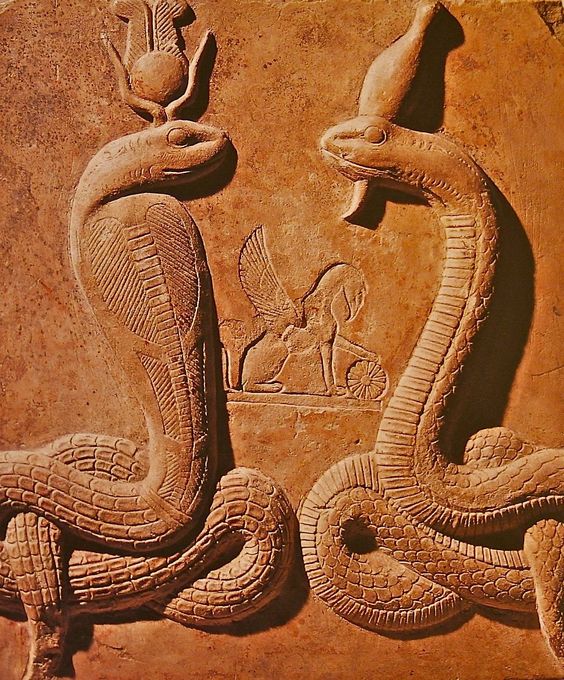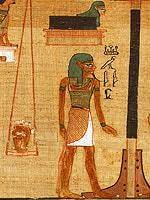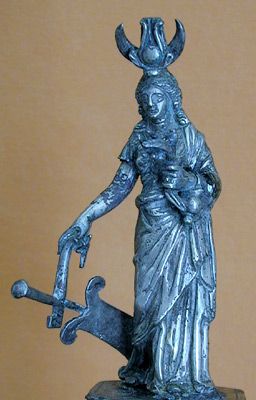Do you believe in Fate?
If we look to ancient Egypt, we definitely find a concept of fate or destiny. It is shai (or shau). Like so many ancient concepts, Fate was personified, in this case as the God Shai. Shai comes from a root word meaning to ordain; as in that which is ordained. Often in ancient Egypt, what they thought was ordained was the length of one’s life. And, also often, this was connected with one or another of the Deities. People prayed that the Deities would lengthen their time on earth.
In some of the Egyptian folk tales we have left to us, the time and sometimes the manner of death is decreed at birth by the Seven Hathors. In the story of the birth of the three kings, the Birth Goddess Meshkhenet is the one Who declares the destiny of the newborn kinglets. The Goddess Renenutet (or Renenet) is also a Destiny Goddess and could decree the prosperity a person might have in life. Shai and Renenutet are sometimes paired as Fate and Fortune or Fate and Destiny.
Those of you who have been following along with this blog won’t be surprised to find that Our Lady of Ten Thousand Names was syncretized with each of these Fate-connected Goddesses.
We already know Her as as Lady Luck. But there is an even more important Isis-Fate connection. And that is, that She is the Ruler of Fate. In Her 1st century CE aretalogy from Kyme in Asia Minor, Isis says, “I overcome Fate. Fate obeys me.” In Egypt, She is called Mistress of Fate (Nebet Shai), Who Creates Destiny; She is Mistress of Life, Ruler of Fate and Destiny. At Aswan, She is “the One under Whose command fate and destiny is.”
Interestingly, sometimes the hieroglyphs for shai were determined (that is, they have another glyph at the end that gives the overall sense of the word) with the sign for either “death” or “time.” Surely this is because of the Egyptian connection between one’s fate and the time of one’s death. We already know Isis is connected with death and the otherworld. But She is also a Goddess of Time.
This is most easily seen when She is Iset-Sopdet or Isis-Sothis. As I write this, it is summer and the star of Isis, Sirius, is absent from the night sky. It will be some time before I can see Her rise before the sun in the dawning light.
As Isis Sothis, Isis controlled the time of the seasonal, all-important Nile Inundation by the rising of Her star. She is also connected with the timekeeping Egyptian decans, which are 36 stars or smaller groups of stars (asterisms). As the earth turns, each decan is visible for a period of about ten days (or 10 degrees of a 360-degree circle), after which another one rises, marking 360 days of the year. To get to 365, the Egyptians added the five epagomenal days that were “outside” of the year—and during which the birthdays of Osiris, Horus, Set, Isis, and Nephthys were celebrated. In addition to their yearly timekeeping, tracking the decanal stars and asterisms through the night sky served as a star clock for the Egyptians as they counted off the twelve Hours of the Night.
I’ve seen two different Egyptian names for the decans (decan is Greek for “a tenth”): baktiu and ankhiu. Baktiu, means “those who work” because, when it rose, each decan was said to be “working.” Ankhiu, as you might guess, means “living ones” because, as it rises, each decan is considered to be born. Iset-Sopdet is the first of the decans. Her heliacal rising just before the sun marks the beginning of the New Year. She leads and rules them all.
The Queen of the Decans is also the year as a whole, including what happens within that year. In Memphis, Isis-Hathor is called Renpet, the Year. One of the Oxyrhynchus papyri records one of the names of Isis in the Greek port city of Leuce Acte as Eseremphis, which is a Hellenized version of Iset Renpet. As the Year Itself, Isis decrees what fate each year brings. Horapollon, writing a late work on the meaning of hieroglyphs, says,
When the Egyptians want to represent the year they draw Isis, that is, a woman. And they signify the goddess in the same way. And among them, Isis is a star, called Sothis by the Egyptians, by the Greeks the Dog Star, which appears to rule over the other stars. Now greater, now less as it rises, and now brighter, now dimmer. And according to the rising of this star, we note how everything during the year is going to happen. Wherefore it is not unreasonable to call the year Isis.
Horapollon, book 1, entry 3
The temple of Ptah at Memphis was known (among other names) as “the Balance of the Two Lands.” The devotees who inscribed the Isis aretalogy at Kyme, in which Isis declares that She overcomes fate, wrote that they had copied it from a stele that stood in front of the Memphis temple of Hephaestos, that is, Ptah. German Egyptologist Heinrich Brugsch commented in his thesaurus of Egyptian inscriptions that the Egyptian New Year’s festival was “the great festival at which the whole world is brought into balance, when the birth of Isis takes place.”

During the period of Roman rule in Egypt and across the Roman empire, people were feeling particularly pressured or bound by Fate. Astrology had gained general popularity, yet people felt constrained, not enlightened, by “their stars.” So we can easily understand the appeal of a Goddess Who, as the Kyme aretalogy says, regulates the pathways of the stars and orders the course of the sun and moon—and Who also frees those who are in chains.
We find all these themes in Apuleius’ story of initiation into the Mysteries of Isis. When he comes into Her service, Lucius is freed from his asinine state (he had been turned into a donkey). Isis, a Goddess of Fortune Who sees, replaces the Blind Fortune that had been tossing Lucius to and fro. Instead of implacable Fate, he is now allied with Invincible Isis, Victorious Isis, Triumphant Isis—Isis Who is Providence Itself.
As She always has been, Isis is Nebet Ankh, Henut Shai yt Renenet, Mistress of Life, Ruler of Fate and Destiny. And perhaps in these unsettling times, we too need a Goddess Who can overcome Fate…or help us to do so ourselves.
And so, let us commune with Isis—invoke and make offering to Her. Let us work magic under Her wings and then work in the world toward a better destiny for us all.










